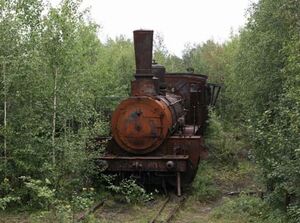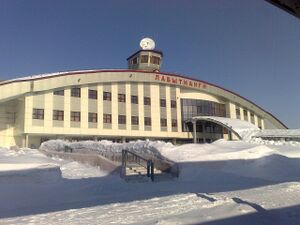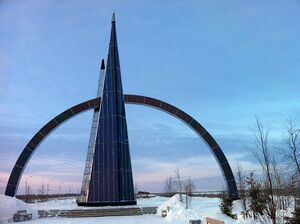Salekhard
| Salekhard | |||||
|---|---|---|---|---|---|
| Japanese Name | サレハルド | ||||
| Weapon | |||||
| Race | Human | ||||
| Nationality | |||||
| Birthday | March 20 | ||||
| Constellation | Pisces | ||||
| Talents | Espionage activities | ||||
| Likes | Mother's bad home-cooked food | ||||
| Dislikes | Nothing in particular | ||||
| Strengths | What needs to be done will be done right up to the end | ||||
| Weaknesses | Not good at operating independently | ||||
| Hobbies | Nothing in particular | ||||
I'm Salekhard of the M. Eisengrad Railway Army. I was in a secret unit that was tasked with tracking and monitoring Vorkuta. Family? Now I have only my mother Igarka. Igarka and I are now real family.
Layers
| Icon | Title | Release Date | Where to Obtain |
|---|---|---|---|
| [Voltarja Secret Intelligence Service] Salekhard | 2023 August 8 | [Training Camp - Salekhard] Event Reward | |
| [Freezing Eyes] Salekhard | 2023 August 1 | [Snow Fairy and the First Excursion] Event Reward | |
| [The State of Sem'ya] Salekhard | 2023 July 31 | [Snow Fairy and the First Excursion] Pick Up Gacha, Premium Gacha |
Skills
Trivia
- The design of Salekhard's staff is based on Labytnangi coat of arms.
- The illustration border of [The State of Sem'ya] and the overall color scheme is a reference to the Salekhard coat of arms.
- The monument in the background of [The State of Sem'ya] is the Salekhard Polar Circle Memorial (66°33'03.0"N 66°37'36.2"E).
- Salekhard's cape resembles the Polyaris Entertainment center in Salekhard, with the beads on the left and the metal bars on the right being similar to the building's design.
- [The State of Sem'ya] title in Japanese (『家族』のかたち) is a reference to a Japanese drama show titled 家族ノカタチ, called 'The State of Union' in English. Sem'ya is Russian for 'family'.
- Neve is Italian for 'snow', Lepus is Latin for 'rabbit', and Sosul'ka is Russian for 'icicle'.
Counterpart
The 1,524 mm (5 ft) broad gauge Salekhard–Igarka Railway, (Трансполярная магистраль Transpolyarnaya Magistral, i.e. 'Transpolar Mainline') also referred to variously as Dead Road (Russian: Мёртвая дорога), and Stalinbahn, is an incomplete railway in northern Siberia. In 1952, officials permitted a reduced tempo of work. Construction was stopped in 1953 after Stalin's death. A total of 698 kilometres (434 mi) of railway were completed at an official cost of 260 million rubles, later estimated to be near 42 billion 1953 rubles (2.5% of total Soviet capital investment at the time, or about $10 billion in 1950 dollars). Construction was coordinated via two separate Gulag projects, the 501 Railway beginning on the River Ob and 503 Railway beginning on the River Yenisey, part of a grand design of Joseph Stalin to span a railway across northern Siberia to reach the Soviet Union's easternmost territories. The planned route from Igarka to Salekhard measured 1,297 kilometres (806 mi) in length. The project was built mostly with prisoner labour, particularly that of political prisoners, and a large number perished. The project was quickly destroyed by frost heaves and structural failures arising from poor construction. At least 11 locomotives and 60,000 tons of metal were abandoned, and bridges gradually decayed or burned down. However, the corridor's telephone network remained in service until 1976.
Around the year 2000, discussion began about building a railway to Norilsk, about 220 km from Igarka, following much of the original corridor, to support the nickel and petroleum industry. Known as part of the Northern Latitudinal Route, new construction of the railway section between Salekhard and Nadym allegedly started on 19 March 2010 in Salekhard. This section was originally proposed to be finished in 2014 and opened in 2015, with combined road-rail bridges across the Ob and Nadym rivers, thus connecting to the existing Russian railway system at both ends. As of 2016, the reconstruction of the Salekhard-Nadym line (in 1,520 mm (4 ft 11+27⁄32 in) gauge) was projected to take place between 2018-2022. As of April 2020, the Salekhard-Nadym line construction was ongoing, including a new bridge where the line crosses the Ob river. The process is expected to be complete in 2030. Wikipedia
Labytnangi railroad station is a railway station of the Sosnogorsk Region of Northern Railway, located in the town of Labytnangi, Yamalo-Nenets Autonomous District, Tyumen Region. The station is the terminus on the line from the Chum junction station. There is no suburban service to the station. The opening of the railway station took place in May 2004 and coincided with another significant event - the launch of the luxury train 'Polar Arrow' - offering services such as children's playing compartments, internet-compartment, satellite communication, shower rooms, and ironing rooms. The railway station is designed by Omsk design engineers, constructed as if it was a segment of the polar circle standing out of the ground. Facilities in the station includes: service center, vast departure lounges, nursery rooms for mothers with children, international phone boxes, satellite communication, and an electronic waiting system. Wikipedia study.ufru.ru
Salekhard (Russian: Салеха́рд; Khanty: Пуӆңават, Pułñawat; Nenets: Саляʼ харад, Saljaꜧ harad) is a town in Yamalo-Nenets Autonomous Okrug, Russia, serving as the okrug's administrative centre. It crosses the Arctic Circle, the main parts being about 1 kilometer (0.62 mi) south and suburbs stretching to the north of the circle. It was situated on the Ob River, and its name supposedly derives from that. The land around Obdorsk was referred to as Obdorsky krai, or Obdoriya. The town was often used as a place of exile during the Tsarist and Soviet periods. Among notable people who spent time here were the Doukhobor spiritual leader Pyotr Verigin and Leon Trotsky. The town and nearby area contained three Soviet camps where approximately 6,500 prisoners were held, arrested for their belief in God. At the port of Salekhard, approximately 1,500 prisoners loaded and unloaded goods at the dock, or mined metal ores.
Salekhard is located in the Ob river valley and is an important river port of the Russian Far North. The unfinished Salekhard–Igarka Railway was set to provide a rail connection between the Ob river port of Salekhard and the Yenisei river port of Igarka. Currently, the nearest railway is at Labytnangi, 20 kilometres (12 mi) northwest on the opposite side of the river Ob. The project Northern Latitudinal Railway will provide Salekhard access to Russian railway and will further connect Salekhard to the Konosha–Vorkuta railway and other parts of European Russia. The Salekhard Bridge project, a combined railway-road bridge over Ob river, is the main component of Northern Latitudinal Railway that will connect Labytnangi and Salekhard is to be constructed with the cost of 60 billion rubles. Nadym–Salekhard road, a 344 km long road, was inaugurated in December 2020 to the 90th anniversary of the Yamalo-Nenets Autonomous Okrug, it will facilate the construction of a railway between the two cities and connects the eastern and western parts of Yamal Okrug. The nearest railway station is at Labytnangi on the opposite side of the river Ob. From 1949 to 1953, the Salekhard-Igarka Railway project made an unsuccessful attempt to extend the line to Igarka, claiming the lives of thousands of Gulag prisoners. The section of railway from Salekhard to Nadym was completed and remained in use for some time in the Soviet era, although it was later abandoned. It is being rebuilt since 19 March 2010, along with a long-awaited bridge across the Ob between Labytnangi and Salekhard. Wikipedia
Map
Gallery
- Pages using Tabber parser tag
- Pages using DynamicPageList3 parser tag
- Weapon Staff
- Human
- Eisengrad
- Pisces
- Element Blow
- Element Water
- Metro Train Knights
- Russia













